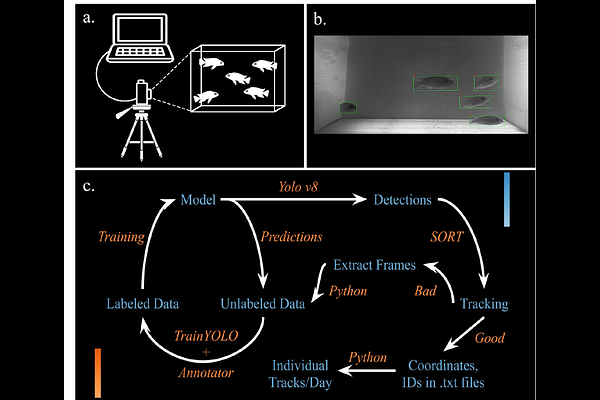Cryptic and Ecologically Relevant Locomotor Activity Patterns in Lake Malawi Cichlids Revealed Through Computer Vision Pipeline

Cryptic and Ecologically Relevant Locomotor Activity Patterns in Lake Malawi Cichlids Revealed Through Computer Vision Pipeline
Holtz, N.; Lloyd, E.; Holtz, C.; Keene, A.; Albertson, C.
AbstractCichlid fishes have long been a popular model for ecology and evolutionary biology. Not only do they exhibit nearly unparalleled taxonomic diversity, but their community structures are both complex and extremely dense. Niche partitioning along dietary axes has been credited in maintaining cichlid biodiversity in a broad sense; however, it is common for cichlid species with overlapping diets to co-exist, leading to the search for other mechanisms to explain the maintenance of cichlid biodiversity. Behavioral variation has the potential to lead to fine-scale (i.e., micro-) habitat partitioning, but analyzing complex animal behavior poses several challenges, including time, cost and reproducibility. Modern tools, such as Machine Learning (ML), ease the burden of behavioral analyses, and are increasingly used in the field. Here, we present the application of tools from a well-developed sub-field of ML, Computer Vision (CV), to extract locomotor behavioral data from four Lake Malawi cichlid species. Our dataset consisted of low-resolution (320x240), twenty-four-hour infrared videos of activity in 4 cichlid species. We first analyzed a pair of species with divergent behaviors, diets and habitats (i.e., Abactochromis labrosus versus Tropheops kumwera), representing a proof-of-concept comparison. Next we analyzed activity in two closely related species with broadly similar behaviors and overlapping diets and habitats (i.e., Maylandia sp. \"Daktari\" versus Maylandia faiaziberi). In both comparisons, our analysis involved the quantification of tank usage patterns and stop/rest activity. Not only did our data align with the known ecologies and behaviors of the species in our proof-of-concept comparison, but they revealed novel behavioral differences between all species, especially as related to variation in tank usage from day to night. Our approach provides a window into potential cryptic behavioral niche partitioning, as well as a foundation for future, high-throughput analyses to study the genetic basis and evolution of behavior.